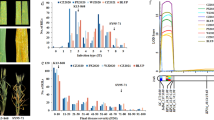Abstract
Out of 71 selections of wild emmer wheat which were involved in this study on the inheritance of resistance to yellow rust, 45 selections gave conclusive results. The most common finding was that the observed segregation ratios in the F2-progenies indicated that the resistance is based on one or more dominant genes (67%). Less frequently, resistance may be conferred by one or more recessive genes (18%), or a combination of both dominant and recessive genes (15%). At least eight different genes have to be involved in the 45 wild emmer selections in order to account for our findings.
Samenvatting
In dit onderzoek werden 45 resistente wilde-emmer selecties (Triticum dicoccoides) gekruist met de vatbareTriticum durum cv. D447 om na te gaan hoe de resistentie van de wilde-emmer selecties overerft. De ouders, de F1- en F2-populaties van een bepaalde selectie werden in het kiemplantstadium getoetst met één Israëlisch gele-roest isolaat van fysio 2E0 of van fysio 2E18. In de uitsplitsende F2-populaties werden de nietsporulerende planten als resistent beschouwd en de sporulerende als vatbaar.
De waargenomen uitsplitsingsverhoudingen komen overeen met 9 verschillende theoretische uitsplitsingsverhoudingen in de F2. Het meest voorkomend (23 herkomsten) was een R∶S=3∶1 uitsplitsing, wijzend op één dominant gen. In zes herkomsten lijken twee dominante genen aanwezig te zijn, die in drie gevallen onafhankelijk overerven (15∶1) en in de andere drie complementair (9∶7). In één herkomst lijkt de resistentie op tenminste drie dominante genen te berusten, daar alle 256 getoetste planten resistent waren. Een uitsplitsing wijzend op één dominant gen samen met één of twee recessieve genen (13∶3 of 55∶9) werd in zeven herkomsten gevonden. Resistentie berustend op uitsluitend recessieve genen werd aangenomen in acht herkomsten. In drie gevallen erven deze genen onafhankelijk over (1∶3 of 7∶9), in de overige vijf complementair (1∶15).
Concluderend kan worden gesteld dat de resistentie in dit wilde-emmer materiaal in de meeste herkomsten (67%) op uitsluitend dominante genen lijkt te berusten, of op een combinatie van dominante en recessieve genen (15%). In de overige herkomsten (18%) lijkt de resistentie te berusten op uitsluitend recessieve genen. Om de gevonden resultaten te kunnen verklaren moet worden aangenomen dat er tenminste acht genen zijn betrokken bij de resistentie in deze wilde-emmer herkomsten.
Similar content being viewed by others
References
Gassner, G. & Straib, W., 1928. Untersuchungen über die Infektionsbedingungen vonPuccinia glumarum undPuccinia graminis. Arbeiten aus der Biologischen Reichsanstalt 16: 609–629.
Gassner, G. & Straib, W., 1932. Die Bestimmung der biologischen Rassen des Weizengelbrostes (Puccinia glumarum f.sp.tritici (Schmidt) Erikss. et Henn.). Arbeiten aus der Biologischen Reichsanstalt 20: 141–163.
Gerechter-Amitai, Z.K. & Grama, A., 1974. Inheritance of resistance to stripe rust (Puccinia striiformis) in crosses between wild emmer (Triticum dicoccoides) and cultivated tetraploid and hexaploid wheats: I.Triticum durum. Euphytica 23: 387–392.
Gerechter-Amitai, Z.K. & Stubbs, R.W., 1970. A valuable source of yellow rust resistance in Israeli populations of wild emmer,Triticum dicoccoides Körn. Euphytica 19: 12–21.
Gerechter-Amitai, Z.K., Grama, A., Silfhout, C.H. van & Kleitman, F., 1989. Resistance to yellow rust inTriticum dicoccoides. II. Crosses with resistantTriticum dicoccoides sel. G-25. Netherlands Journal of Plant Pathology 95: 79–83.
Grama, A. & Gerechter-Amitai, Z.K., 1974. Inheritance of resistance to stripe rust (Puccinia striiformis) in crosses between wild emmer (Triticum dicoccoides) and cultivated tetraploid and hexaploid wheats: II.Triticum aestivum. Euphytica 23: 393–398.
Grama, A., Gerechter-Amitai, Z.K., Blum, A. & Rubenthaler, G.L., 1984. Breeding bread wheat cultivars for high protein content by transfer of protein genes fromTriticum dicoccoides. In: Cereal grain protein improvement, Proceedings Meeting International Atomic Energy Agency (IAEA), Vienna 1982, pp. 145–153.
Silfhout, C.H. van & Groenewegen, L.J.M., 1984. The use ofT. dicoccoides in winter wheat breeding. Proceedings VIth European and Mediterranean Cereal Rusts Conference, Grignon (France), pp. 129–132.
Silfhout, C.H. van & Drenth, H., 1988. Genetical analysis of adult plant resistance in winter wheat to yellow rust. Proceedings VIIth European and Mediterranean Cereal Rusts Conference 1988, Vienna/Austria, pp. 24–26.
Author information
Authors and Affiliations
Rights and permissions
About this article
Cite this article
van Silfhout, C.H., Grama, A., Gerechter-Amitai, Z.K. et al. Resistance to yellow rust in Triticum dicoccoides. I. Crosses with susceptible Triticum durum. Netherlands Journal of Plant Pathology 95, 73–78 (1989). https://doi.org/10.1007/BF01997475
Accepted:
Issue Date:
DOI: https://doi.org/10.1007/BF01997475




